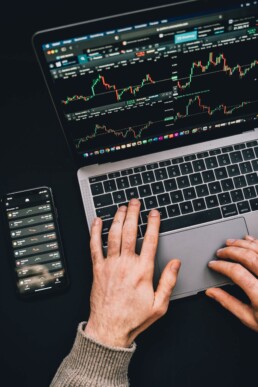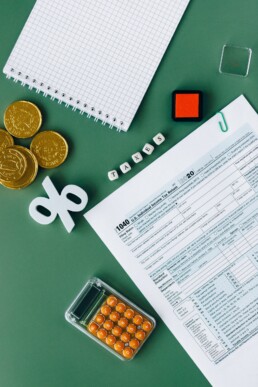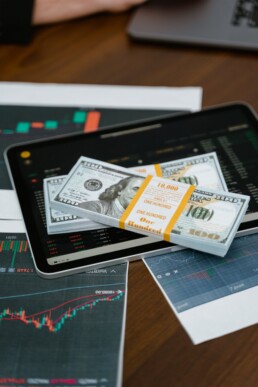Gold
Since ancient times, gold has been associated with wealth, money and well-being for those who owned even a small part of this asset. It was one of the most sought after materials extracted from the bowels of our planet, and the human being has always seen the value given by its scarcity.
Used since the dawn of time to give value to the currency of all peoples, we Westerners had the gold standard until the beginning of the 20th century, in fact the value of the currency issued by our central banks was linked to gold, which guaranteed its value.
This system was completely abandoned in 1971, but many still consider gold a fundamental asset for their investment portfolio.
In fact, gold is considered a refuge or a safe haven, where to take refuge every time the shadows of galloping inflation returns to disturb our sleep. Especially for critics of fiat currencies, gold is an excellent investment to maintain or increase the value of one's investments and to protect themselves from the wild printing of money created with Fiat currencies
Remember that gold is a finite resource on our planet, hardly available and in limited numbers.
Central banks in countries that didn't have much have been buying it up in recent years.
Many countries have large quantities declared while other countries have preferred to discard them. This is a good example of the different strategy of the various central banks.
Gold is also an industrial metal used in the production of electronic parts. In reality, its industrial demand is a small part of the world total, to which must be added the demand for raw materials for the production of jewelry.
Now we should ask ourselves, is it right to invest in Gold?
Well, as in all things, there is a better time to do things, and these can only be understood by studying the set-up in detail
Having a share of capital in gold is not stupid, quite the opposite. However, this must be seen primarily as a defense tool. This does not mean that you cannot make money with gold, but as always you have to follow the trend.
If we talk about price, by convention and general rule, the price of gold grows more and more than inflation and this is not related to the trend of the stock market.
In the event of a stock market crash, there is usually a rush to grab gold, and then sell the gold when the stock market rises vigorously
However, Gold has a volatile price and not a fixed price. The period and time of purchase must always be considered and what tools we are monitoring.
In fact, there are more methods and tools to be invested in gold.
The main differentiation is between physical gold and financial gold.
Financial gold is the gold that we can buy through financial instruments such as ETFs and ETCs, futures or derivatives. In this case we will not physically have gold in our hands but we will have financial contracts that represent the amount of gold we own that we will be able to trade on the main world markets. Obviously in this case the choice must be careful with regard to the instrument and all its peculiarities, relying on issuing companies that are more than reliable.
Physical gold, on the other hand, is the gold that we can take home and touch with our hands. Generally it is not just about jewelry, but also coins or bars, which can range from a few grams to a kilogram. The unit of measurement of gold is the ounce compared to the US dollar. This gold can be kept in your home, obviously safe from buglar or scammers. Given the high value of the metal, if you decide to buy more than a few ounces, it makes sense to contact specialized custodians to keep our investment safe.
In fact, there are real risks to owning it, not just financially, but personally. Gold is not an investment for everyone.
Another way to be part of this market is to expose yourself by buying shares in mining companies. This is another method which, however, is totally financial and which must be considered and studied like any financial investment, to which the risk of the sector in which these companies operate must be added.
Long or Short
This is a short article that will explain some of the terms that you can find in the world of trading.
Learn more about exchange here and here.
You will often hear from people in the environment talking about being Long or being Short
This is the result of a diametrically opposite view of the market by the trader.
Being Long means having purchased the financial instrument.
Being short means having borrowed the financial instrument.
In fact, in the world of trading we can not only buy an asset, assume a share or a cryptocoin, but also borrow it. It all depends on how we consider the future trend of this action, like the rise or fall of the price.
The market can be defined as bullish or bearish, in the event that it is increasing in value or losing value. There are two animals that describe the uptrend or the downtrend
The bull is the uptrend market. In fact, it is defined as the bull market. The bull strikes from the bottom up.
The bear is the downtrend market. Hence Bear Market, as the bear strikes from top to bottom.
Long means being the owner of the asset. Our hypothesis is that the market is bull so the asset's value will go up so we will wait for the value to rise to sell it at a higher price
Being short means that we think the value of an asset will go down, we will be in a bear market, so we are going to borrow the asset from a lender. We will sell our asset at € 5, it will drop to € 3 and we will buy it back at this amount so as to give it back to the previous lender. The 2 euro difference is your earnings
Always check your broker's costs regarding being short, they must be carefully monitored to manage them in the best possible way.
How negative interests works
Today we explore the topic of interest rates, and we will see what negative interest rates are and how they operate.
What is a negative interest rate?
A negative interest rate is a loan, granted by a financial entity, where you do not pay to take money but you are paid to access this loan.
A debtor who is paid to take a debt.
Fantastic.
BUT What do negative interests on the economy really mean?
Interest is the amount that you pay to the bank to borrow money for your business or family activities, or it is the money that is credited to you by the bank to hold your funds in your bank account.
The low rates are created to push banks to increase lending and not keep a lot of liquidity stored in their accounts, flirting with customers that need to access these low-cost loans.
High interest rates are used to push people to spend less and try to keep inflation under control by cooling the economy.
The opposite is created by lowering rates.
The ECB European Central Bank started with negative rates in 2014 while the central bank of japan started in 2016
With negative rates, banks will begin to lose profit from the money deposited in their customers' accounts.
Negative interest also means that deposit accounts and money held on checking accounts will be paid at zero or you will have to pay to keep yopur accounts in the bank. In this case the bank could decide to absorb this cost from their customer if they take other products of the bank such as insurance, mortgages, etc.
It happened in denmark that a bank applied a rate of -0.5%
Consumers are so discouraged from keeping cash in their checking accounts and are therefore pushed to spend. This affects the entire economic chain, both private and corporate.
The costs for loans to the public will certainly be higher than those that the bank will have, after all it is their business
In the case of negative interest decided by the central bank, consumers do not necessarily have to have negative interest on their loans as well.
At the moment, we do not fully understand the real consequences of negative interests on the real economy, despite the fact that these seem an excellent thing to the man in the street.
Theoretically, low or even negative rates serve to push the economy with greater consumer spending, a greater propensity to borrow and a growth in consumption and therefore a growth in inflation.
With inflation, or the growth of consumer prices, there is a loss in value of the currency of the country that is the victim,
which means a greater possibility of selling their products abroad given their lower value at the exchange rate with competitors, another boost to the demand for goods and services.
All good, if it happens.
The countries that are now protagonists of this financial policy based on negative rates have had problems with chronic slow growth and are therefore in deflation.
Deflation encourages banks and people not to spend their money.
Deflation leads to the cycle more saving less spending. negative interests are seen as a method to discourage this cycle and indeed reverse it
Negative interests can have many negative effects on the economy and the population. People may decide to own their savings in physical currency, creating a run at ATM instead of keeping their cash in bank accounts and then paying the banks fee.
Financial bubbles are another effect, people could borrow to an unsustainable level and then create a financial bubble, with all that goes with it. Do you remember our toxic assets?
Which means making risky investments with money that savers cannot afford to lose. In the event of a crash the situation would be really problematic.
Negative interest then affects savers and bond investors. Savings are no longer remunerated and bond yields go to 0,
the risk is no longer correctly remunerated, creating market distortions, which leads to an increase in the risk in the investment portfolio to maintain the same level of remuneration.
Think about how all pension funds and bond funds are affected
Companies take debt money not to create new production lines or increase their workforce, but to buy back their shares, artificially increasing their value on the market
Banks are also affected, as this action greatly lowers their profits on loans and other products.
Negative rates can be seen as paradoxical and controversial
Negative rates on various bonds lead to not placing the bonds on the market, since in a normal market no one lends their money without having an economic return.
On the contrary, we must mention the Safe haven bonds have a low if not non-existent yield, but we are talking about bonds issued by countries considered “safe” and “unshakable”.
Shadow Banking
Today we are going to learn what is the Shadow Banking,
While the name may sound like something secret or illegal, this is just a parallel system to the traditional banking system for lending to individuals and businesses. Nothing illegal
Let's take an example to simplify the general explanation and understand how this system works, and probably you have used it without even thinking about it or knowing it. We use simple and easy numbers, purely for explanatory purposes.
Luca needs a loan to renovate his house, he goes to his bank and asks for an amount X. Luca is a good payer and therefore the bank would grant him the loan at a rate of 5% per year
However, Luca is not satisfied and remembers that a colleague suggested the CCX Finance. CCX deals with loans for real estate, cars, university and more.
Luca shows up in one of the CCX offices and the same loan for the same amount X would have a rate of 3.5%.
Luca as a customer does not find differences in the two loans, his only interest is in having the amount X he needs at the lowest available cost in the same agreed period of time.
So Luca for his convenience chooses to make a contract with the CCX
Here is an example of shadow banking.
The problem with shadow banking is how it is done or created. The banking circuit is created by people who save, and this savings goes into their current bank accounts. these current accounts are remunerated at 1%
the banks take this money, in customer accounts, and lend it to people like luca, at a rate of 5%. The difference between account yield and loan rate is the bank's business
CCX, on the other hand, having 200 Luca accessing his loan service, transforms the series of loans made to its customers into a derivative financial product.
Inside there will be loans whose risk will vary, as people will be different and with a different financial history, from the safest to the most risky.
Obviously the greater risk will be more rewarded by customers with a worse financial history
This financial instrument will then be bought by someone, in this case from a pension fund, as its return on the market makes it extremely attractive.
the currency of the purchase of the instrument will enter into CCX, which will thus be able to create other loans to others Luca, loans which will be transformed into derivatives and sold to other funds and so on without stopping
As far as banks are concerned, there are strict regulations, especially after the 2008 crash. These regulations serve as a safety net for the banks and consequently for its customers.
Let's talk about capitalization and specific rules to save your deposited money
In companies like CCX, on the other hand, there is no safety net or if there is, it is very thin given the low or almost no regulation
Over the various years, the percentage of loans disbursed by banks in relation to loans disbursed by shadow banking has increasingly been in favor of the latter.
The main risk arises in the creation of the derivative financial assets that have the debts inside. The economic situation could change to a worse one, These debts could become bad debt and therefore waste paper. The problem would spill over to those who are the holders of the derivative securities, which could go to a value equal to zero and therefore cause the funds that hold them to fail.
On the other side of the fence, in the event of a lack of financial stability, the funds interested in purchasing these derivatives could be scarce, putting companies like CCX in difficulty and causing their customers to return to the banking world for liquidity. necessary.
Hedge Funds
It is not uncommon to hear about hedge funds in the general media.
As the name implies, it is a fund involved in a hedging strategy.
We are talking about hedge funds because they are sometimes responsible for the volatility of the stock markets and because it is not always clear to the man of the street what they are, how they are composed and how they work.
Every hedge fund has rules that absolutely must be followed by the fund creator.
Regulations changes from country to country, such as the percentage of accredited investors or the type of investments that can be made. In addition, each fund has internal regulations to better manage its existence.
Generally, hedge funds in the Western world are allowed to purchase all financial assets recognized by their regulatory entities. But I advise you to specifically check the regulations of your country of residence in order not to make mistakes, all before investing.
It happens very often that the creator and manager invests a large chunk of their money in hedge funds. We are talking about a few million dollars, so as to push other investors to trust him given the particularly high personal figure involved.
After that there will most likely be a minimum amount to invest in the fund, which could be 500k or $ 1 million. in this way he will have a sufficient amount of liquid to invest and will have to deal with a low number of people, more easily manageable.
One of the rules that could be decided by the manager is to freeze the funds for a certain period of time which could be one or two years. In this way the manager will be able to invest liquidity in instruments that are also very risky without having problems of lack of funds due to an investor who wants to exit the fund.
Again for this issue, the manager could add to his rules a limited time window for the repayment of the capital added to the fund, such as once or twice a year.
The manager will have a large variety of assets to invest in, and to hedge the risk of these investments he will have hedging techniques by investing in derivatives and other instruments.
Obviously the manager can be both long and short on chosen assets, with a long investment and another short to cover the risk of the long.
the manager's remuneration will be a percentage, and may be a small percentage of the initial paid with a larger percentage of the gain achieved (in the order of 20, 30 or 40 percent)
Now, one of the riskiest moves that the manager can make is to take advantage of financial leverage, that is to ask for a loan from a bank. Let's assume a 5 to 1 leverage, with the manager having 10 million dollars under management and receiving 50 million from a bank, for a total invested liquidity of 60 million.
Both the financial leverage and the limited repayment window are the topics that can worry the most during a possible crisis or collapse of the markets
in fact, many investors may prefer to remain liquid and not invested in the market, so they may request redemption.
In this case, the fund should liquidate its assets very quickly.
This rapid liquidation would lead the market price to fall even further, especially if it is not just a fund that has to liquidate but a large number of funds.
You understand that the figures involved are very high and the speed of sale must be in line with the requests of the investors. The exit from the market, if done in a moment of panic, could also be very painful for the customer portfolio and even more so for the manager with the possible cancellation of the fund.
Quantitative Easing
QE rose up in the international stage during the subprime debt crisis during 2008 in the United States.
QE been created by the Federal Reserve in multiple tranches over the years and the latest tranche is QE5 which was started in spring 2020 during the global Covid 19 crisis, although the Fed no longer calls it QE. But ultimately it's a QE.
This system is one of the central bank's weapons to incentivize banks to make loans, both among themselves and to their customers, companies or individuals like you.
QE was born because there was a block in the loan cycle so lets go into detail.
QE was a novelty in the management of the US central bank as it had never happened that the Fed had to intervene so massively in the market with so much liquidity.
The principle behind QE is simple, in fact it serves to incentivize or rather to push banks to lend money. This is to bring the money crammed into the banks into the real economy.
Banks can take money from the central bank at very low cost, but instead of lending to various companies that need liquidity, banks invest in 10-year government bonds
The lending activity is risky, the loan may not be repaid and therefore the money can be lost by the bank. Government bonds, on the other hand, are safe assets that have a return so the risk is zero and the gain is safe with the coverage of the Washington government.
This kind of activity, if done on a large scale by most banks, creates a slowdown or block in the flow of credit, which could slow the economy if it does not push it into a downward spiral.
The Fed therefore intervened to avoid this situation by creating quantitative easing, which is nothing more than a pumping of money into banks and the real economy.
First step, the Fed start to buy financial assets directly from banks, taking financial instruments and derivatives of any quality including many toxic assets, debts and derivatives
The Fed gave fresh money to Banks to buy their bad securities, eliminating some if not all of the heavy pressure on banks.
After that the Fed began buying American government bonds that the banks themselves bought. This is to help the US government finance itself and keep rates low, driving yields down. with low yield, banks are no longer inclined to buy government bonds which now yield near zero
So the banks to seek yield, in theory, must turn to the public loan market. This forces the banks to go back to banking, or to lend money to healthy and well-managed companies which will then return the money plus the interest rate.
The action of the FED has lowered interest rates making it less expensive to borrow money for the company or private individual in need of cash.
The problem of subprime mortgages should also be mentioned, like mortgages granted in the real estate world to people who are unable to repay the funds taken.
But now we may have a problem, if that doesn't work, it means billions of dollars have been pumped into the economy. This amount of money depreciated the dollar.
Deprecating the dollar means that US products are cheaper to buy on the market but excessive depreciation causes the dollar to lose any value and become waste paper.
This means that no one would want dollars and there would be a possible crash of the currency, which is bad for the economy.
Junk Bond
Junk Bond. Silly term heard on the news before sitting down at the table for dinner. What is it about?
Bond means debt. Government Debt. The term junk in this case stands for garbage, something that should be thrown away.
But when we talk about junk bonds, at the moment we are talking about something very "popular".
With junk bonds we describe high-yield bonds, a yield given by their high risk.
It should be understood that higher the risk of lending money to a company or a country that could be insolvent, the higher the return for the lender must be.
When you go to lend money to risky companies by buying their securities, you are entering a risky business.
These companies may be in some risky businesses or economic sectors or they just have too many debts due to bad management or moments of crisis. By investing in this risk you will end up having big interest at the end of each year or month, depending on the instrument chosen.
Unfortunately, however, if these companies are badly managed you may have some small economic satisfaction at the beginning and then end up losing your capital.
Or on the other hand, these companies are well managed, you will have an excellent return and then get all your investment back.
High Yields companies create bonds that are risky and therefore are considered with a very low rating, therefore with a very high yield on the contrary, the so-called investment grade bonds that have a very good rating score have a lower yield.
But what does Yield mean?
Let's see how the yield of a debt security works like a normal corporate bond, we are not talking about Junk Bond and the figures entered here are by way of example.
let's assume that Luca buys a 100 euro bond from GoGA GMBH, with an annual yield of 5%
So Luca lends 100 euros, and in exchange he has a piece of paper that says that he has lent 100 euros to the GoGa and that at the end of the year at the end of the bond he will receive 100 euros plus 5 euros of interest
the 5 euro of interest is the gain of the financial product and therefore the coupon yield on this bond is defined.
but what happens if luca decides to sell the bond before its maturity
if he sells the bond at a price below 100 (which is the base price of each bond), let's assume 95.
sells the bond to Marco. Marco expires the bond and then receives 105 from the company, so Marco's yield becomes 10 and no longer 5 as in the case of luca
as the bond price falls, the yield increases
on the contrary, if Marco buys the bond at 101, his yield will be only 4, with a decrease in the yield.
this is the basis of how yield works
Airdrop and Bounty
FREE MONEY !!!
I'm sure I have your attention now. And yes, Airdrop and Bounty are free money, well almost.
What are these two terms and what do they hide?
They are neither more or less a method of advertising in the world of crypto
Let's start with the airdrop or launch of tokens from a plane, in fact an Airdrop is nothing more than a rain token delivery on a set of addresses. Generally, airdrops are created by subscribing to some forms, where in the simplest cases you simply enter your email and ethereum address up to more complicated cases where you even ask for a KYC.
The bounties, on the other hand, are a more complicated version of airdrop. The user is asked for a more articulated and complex social action or promotion, for a greater amount of tokens.
Examples could be writing an article or creating a video, or software checks and so on
The limit is only the imagination of the advertising creators.










